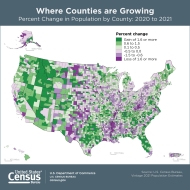Ready?
Over Two-Thirds of the Nation’s Counties Had Natural Decrease in 2021
MARCH 24, 2022 — More than 73% (2,297) of U.S. counties experienced natural decrease in 2021, up from 45.5% in 2019 and 55.5% in 2020, according to the U.S. Census Bureau’s Vintage 2021 estimates of population and components of change released today. Natural decrease occurs when there are more deaths than births in a population over a given time period. In 2021, fewer births, an aging population and increased mortality – intensified by the COVID-19 pandemic--contributed to a rise in natural decrease. The statistics released today include population estimates and components of change for the nation’s 384 metropolitan statistical areas, 543 micropolitan statistical areas and 3,143 counties.
In 2021, all counties in Delaware, Maine, New Hampshire and Rhode
Island experienced natural decrease. Some counties also experienced
population declines attributable to migration. Counties with net
international migration loss (more people moving out of than into the
country), were most frequently found in California (41.4%), Oregon
(27.8%) and Mississippi (23.2%). States with the highest percentages of
counties with net domestic migration loss (people moving from one area
to another within the United States) were Alaska (80.0%), Louisiana
(71.9%) and Illinois (65.7%).
Most of the nation’s counties – 2,063 or 65.6% -- experienced positive domestic migration overall from 2020 to 2021. Arizona’s Maricopa County gained the most (46,866) residents from domestic migration, followed by Riverside County, California (31,251), and Collin County, Texas (30,191). Los Angeles County, California, experienced the greatest net domestic migration loss (179,757 residents), followed by New York County, New York (113,642).
“The patterns we’ve observed in domestic migration shifted in 2021,”
said Dr. Christine Hartley, assistant division chief for estimates and
projections in the Census Bureau’s Population Division. “Even though
over time we’ve seen a higher number of counties with natural decrease
and net international migration continuing to decline, in the past year,
the contribution of domestic migration counteracted these trends so
there were actually more counties growing than losing population.”
In many cases, there was a shift from larger, more populous counties to
medium and smaller ones. These patterns contributed to population
increases in 1,822 counties (58.0%), while 1,313 (41.8%) lost residents,
and eight (0.3%) saw no change in population.
U.S. micro areas, up 0.2% between 2020 and 2021, grew slightly faster than U.S. metro areas, which increased by 0.1%. This is a departure from past trends when metro areas typically grew at a faster rate than micro areas. Among metro areas, 251 (65%) experienced population increases between 2020 and 2021. Of the 543 U.S. micro areas, 287 (52.9%) had population increases in 2021.
Of the 384 metro areas in the 50 states and District of Columbia, 213 (55.5%) experienced natural decrease in 2021, with Pittsburgh, PA (-10,838); Tampa-St. Petersburg-Clearwater, FL (-9,291); and North Port-Sarasota-Bradenton, FL (-6,643) having the highest levels.Sixty-three percent of metro areas had positive net domestic migration, with Phoenix-Mesa-Chandler, AZ (66,850); Dallas-Fort Worth-Arlington, TX (54,319); and Tampa-St. Petersburg-Clearwater, FL (42,089) seeing the largest net domestic migration gains. The largest metropolitan net domestic migration losses were in New York-Newark-Jersey City, NY-NJ-PA (385,455); Los Angeles-Long Beach-Anaheim, CA (204,776); San Francisco-Oakland-Berkeley, CA (128,870); and Chicago-Naperville-Elgin, IL-IN-WI (106,897).
Table 1
Top 10 Most Populous Counties: July 1, 2021 |
|||||
| Rank | State | County | April 1, 2020 (Estimates Base) |
July 1, 2020 | July 1, 2021 |
| 1 | California | Los Angeles County | 10,014,009 | 9,989,165 | 9,829,544 |
| 2 | Illinois | Cook County | 5,275,541 | 5,262,741 | 5,173,146 |
| 3 | Texas | Harris County | 4,731,145 | 4,732,491 | 4,728,030 |
| 4 | Arizona | Maricopa County | 4,420,568 | 4,438,342 | 4,496,588 |
| 5 | California | San Diego County | 3,298,634 | 3,297,252 | 3,286,069 |
| 6 | California | Orange County | 3,186,989 | 3,184,101 | 3,167,809 |
| 7 | Florida | Miami-Dade County | 2,701,767 | 2,692,459 | 2,662,777 |
| 8 | New York | Kings County | 2,736,074 | 2,727,393 | 2,641,052 |
| 9 | Texas | Dallas County | 2,613,539 | 2,610,957 | 2,586,050 |
| 10 | California | Riverside County | 2,418,185 | 2,422,764 | 2,458,395 |
Table 2
Top 10 Counties in Numeric Growth: July 1, 2020 to July 1, 2021 |
||||||
| Rank | State | County | April 1, 2020 (Estimates Base) |
July 1, 2020 | July 1, 2021 | Numeric Growth |
| 1 | Arizona | Maricopa County | 4,420,568 | 4,438,342 | 4,496,588 | 58,246 |
| 2 | Texas | Collin County | 1,064,465 | 1,073,149 | 1,109,462 | 36,313 |
| 3 | California | Riverside County | 2,418,185 | 2,422,764 | 2,458,395 | 35,631 |
| 4 | Texas | Fort Bend County | 822,779 | 828,632 | 858,527 | 29,895 |
| 5 | Texas | Williamson County | 609,017 | 615,266 | 643,026 | 27,760 |
| 6 | Texas | Denton County | 906,422 | 913,900 | 941,647 | 27,747 |
| 7 | Florida | Polk County | 725,046 | 729,233 | 753,520 | 24,287 |
| 8 | Texas | Montgomery County | 620,443 | 624,938 | 648,886 | 23,948 |
| 9 | Florida | Lee County | 760,822 | 764,679 | 787,976 | 23,297 |
| 10 | Utah | Utah County | 659,399 | 663,143 | 684,986 | 21,843 |
Table 3
Top 10 Counties in Numeric Decline: April 1, 2020 to July 1, 2021 |
||||||
| Rank | State | County | April 1, 2020 (Estimates Base) |
July 1, 2020 | July 1, 2021 | Numeric Decline |
| 1 | California | Los Angeles County | 10,014,009 | 9,989,165 | 9,829,544 | -184,465 |
| 2 | New York | New York County | 1,694,251 | 1,687,834 | 1,576,876 | -117,375 |
| 3 | Illinois | Cook County | 5,275,541 | 5,262,741 | 5,173,146 | -102,395 |
| 4 | New York | Kings County | 2,736,074 | 2,727,393 | 2,641,052 | -95,022 |
| 5 | New York | Queens County | 2,405,464 | 2,395,791 | 2,331,143 | -74,321 |
| 6 | California | San Francisco County | 873,965 | 870,014 | 815,201 | -58,764 |
| 7 | California | Santa Clara County | 1,936,259 | 1,930,598 | 1,885,508 | -50,751 |
| 8 | New York | Bronx County | 1,472,654 | 1,466,438 | 1,424,948 | -47,706 |
| 9 | California | Alameda County | 1,682,353 | 1,679,844 | 1,648,556 | -33,797 |
| 10 | Florida | Miami-Dade County | 2,701,767 | 2,692,459 | 2,662,777 | -38,990 |
Table 4
Top 10 Counties in Percent Decline: April 1, 2020 to July 1, 2021 |
||||||
Resident Population of 20,000 or more in 2020 and 2021 |
||||||
| Rank | State | County | April 1, 2020 (Estimates Base) |
July 1, 2020 | July 1, 2021 | Percent Decline |
| 1 | New York | New York County | 1,694,251 | 1,687,834 | 1,576,876 | -6.9% |
| 2 | California | San Francisco County | 873,965 | 870,014 | 815,201 | -6.7% |
| 3 | North Dakota | Williams County | 40,950 | 41,149 | 38,484 | -6.0% |
| 4 | Louisiana | Calcasieu Parish | 216,785 | 216,416 | 205,282 | -5.3% |
| 5 | California | San Mateo County | 764,442 | 762,453 | 737,888 | -3.5% |
| 6 | New York | Kings County | 2,736,074 | 2,727,393 | 2,641,052 | -3.5% |
| 7 | Massachusetts | Suffolk County | 797,936 | 795,431 | 771,245 | -3.3% |
| 8 | New York | Bronx County | 1,472,654 | 1,466,438 | 1,424,948 | -3.2% |
| 9 | New York | Queens County | 2,405,464 | 2,395,791 | 2,331,143 | -3.1% |
| 10 | New Jersey | Hudson County | 724,854 | 722,655 | 702,463 | -3.1% |
Table 5
Top 10 Metro Areas in Percent Growth: July 1, 2020 to July 1, 2021 |
|||||
| Rank | Metro Area | April 1, 2020 (Estimates Base) |
July 1, 2020 | July 1, 2021 | Percent Growth |
| 1 | St. George, UT | 180,279 | 181,924 | 191,226 | 5.1% |
| 2 | Coeur d'Alene, ID | 171,362 | 172,646 | 179,789 | 4.1% |
| 3 | Myrtle Beach-Conway-North Myrtle Beach, SC-NC | 487,722 | 491,582 | 509,794 | 3.7% |
| 4 | Punta Gorda, FL | 186,847 | 187,960 | 194,843 | 3.7% |
| 5 | The Villages, FL | 129,752 | 130,897 | 135,638 | 3.6% |
| 6 | Boise City, ID | 764,718 | 769,581 | 795,268 | 3.3% |
| 7 | Lakeland-Winter Haven, FL | 725,046 | 729,233 | 753,520 | 3.3% |
| 8 | Provo-Orem, UT | 671,185 | 674,967 | 697,141 | 3.3% |
| 9 | Cape Coral-Fort Myers, FL | 760,822 | 764,679 | 787,976 | 3.0% |
| 10 | Logan, UT-ID | 147,348 | 147,796 | 152,083 | 2.9% |
Table 6
Top 10 Metro Areas in Numeric Growth: July 1, 2020 to July 1, 2021 |
|||||
| Rank | Metro Area | April 1, 2020 (Estimates Base) |
July 1, 2020 | July 1, 2021 | Numeric Growth |
| 1 | Dallas-Fort Worth-Arlington, TX | 7,637,387 | 7,662,325 | 7,759,615 | 97,290 |
| 2 | Phoenix-Mesa-Chandler, AZ | 4,845,832 | 4,867,925 | 4,946,145 | 78,220 |
| 3 | Houston-The Woodlands-Sugar Land, TX | 7,122,240 | 7,137,747 | 7,206,841 | 69,094 |
| 4 | Austin-Round Rock-Georgetown, TX | 2,283,371 | 2,299,125 | 2,352,426 | 53,301 |
| 5 | Riverside-San Bernardino-Ontario, CA | 4,599,839 | 4,605,504 | 4,653,105 | 47,601 |
| 6 | Atlanta-Sandy Springs-Alpharetta, GA | 6,089,815 | 6,101,146 | 6,144,050 | 42,904 |
| 7 | Tampa-St. Petersburg-Clearwater, FL | 3,175,275 | 3,183,385 | 3,219,514 | 36,129 |
| 8 | San Antonio-New Braunfels, TX | 2,558,143 | 2,566,683 | 2,601,788 | 35,105 |
| 9 | Charlotte-Concord-Gastonia, NC-SC | 2,660,329 | 2,669,665 | 2,701,046 | 31,381 |
| 10 | Raleigh-Cary, NC | 1,413,982 | 1,420,225 | 1,448,411 | 28,186 |

.jpg)


No comments:
Post a Comment